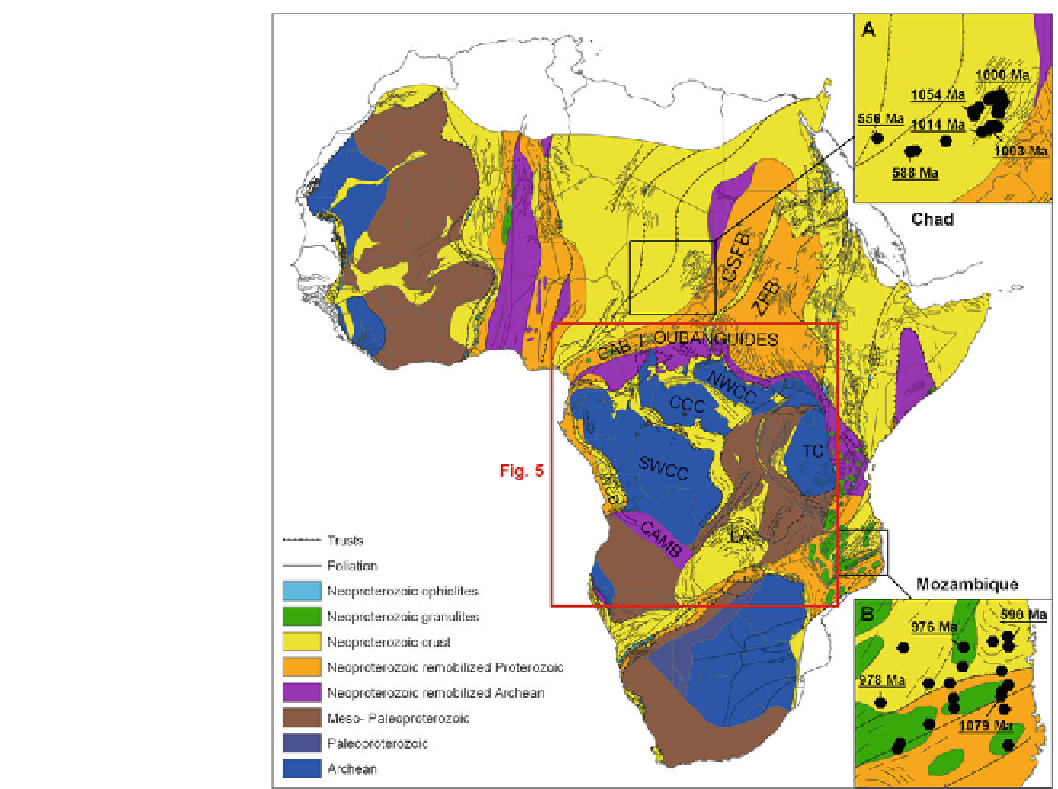Geology Reference
In-Depth Information
Fig. 2.2
Geological map of the
Precambrian basement of Africa
(GIS from de Wit et al.
2008
;
updated), locating the studied
area in central Africa. Black
rectangles detail adjacent regions
with recent data: (A) in Chad (de
Wit et al. under review) and (B) in
Mozambique (Jamal, PhD thesis
2005
)
number of remobilized Archean fragments, and which we here
rename the Central Angola Mobile Belt (CAMB). This belt
separates the rest of the Angola basement to the south, com-
prising predominantly Eburnian-Kibaran (mid-Proterozoic)
crust, from the SWCC. We suggest these two blocks collided
along the CAMB at ca. 2 Ga to form the
boundaries directly flanking the CS and the Tanzanian Craton,
respectively (Fig.
2.3
). This leaves the central Proterozoic
block (including the Paleoproterozoic Bangwuelu Block),
with occasional Archean fragments, as a separate accretionary
region that first amalgamated between the CS and the
Tanzanian Craton during Paleoproterozoic (Eburnian) times.
This terrain was subsequently in part re-melted during the
Mesoproterozoic (e.g.
'
Southwestern Congo
Shield
(SWCS, as first termed by S. Masters in 2004; see
Chap.
1
in this Topic).
To the west of the CS lies a wide region of Proterozoic
basement, including Eburnian (Ubendian), Kibaran and Pan-
African segments that separate it from the Tanzanian Craton.
This intervening region has a complex geologic history that is
still under reconnaissance investigation, and the details
of which are beyond the scope of this chapter. Suffice it
to mention that an Eburnian orogenic belt/suture zone
(the Rwenzori Fold Belt of Tanner, 1974), and the Buganda-
Toro system, e.g. Nagudi et al.
2003
, and references therein
separates the Tanzanian Craton from the NWCC (Mboumou-
Uganda Craton). It is not clear how this Eburnian suture links
up southwards across central Africa, fromUganda and western
DRC through Rwanda, Burundi, western Tanzania to Zambia
and Angola. We show here two likely Eburnian terrain
'
[s.s.] in the
Karagwe-Ankole region; Tack et al.
2010
;Fernandez-Alonso
et al.
2012
) and again deformed within the Kibaran Belt (e.g.
deWaele et al.
2006
,
2008
). Along the Ubendian Belt flanking
the southwestern margin of the Tanzanian Craton, Eburnian
oceanic crust was metamorphosed at low T/high P to eclogite
during subduction at around 1866-1868 Ma, and was subse-
quently re-metamorphosed and re-deformed during Kibaran
and Pan African tectonism (Boniface et al.
2012
; Kabette et al.
2012a
; Lawley et al.
2013
,
2014
). The complexity of this vast
'
the
'
Kibaran Event
'
is yet to be resolved.
Subsequent accretion of other crustal blocks along a num-
ber of orogenic belts surrounding the Congo Shield during the
formation of Gondwana in the late Neoproterozoic-Early
Cambrian created the still larger
Kibaran Shield
'
'
Central African Shield
'

Search WWH ::

Custom Search